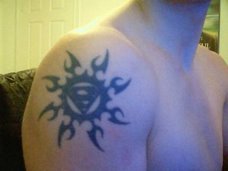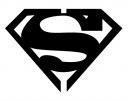What is Body Etching?
Body Etching is a brand new, fascinating, unique and exotic form of Body Art.
It is a mark inscribed upon the skin that is all you! Unlike a Tattoo, there is no ink in an Etching. Unlike Body Piercing, there is no jewelry. Unlike a Brand, the mark is precise, distinct and clear; the results are more controllable and predictable. Etching is a safe, modern, esthetic version of the ancient art form of scarification.
A Body Etching is essentially a scar, in many cases ultimately raised and light or “white” in color. An Etching, once thoroughly healed, may somewhat resemble a white tattoo. Unlike a white tattoo, it will not tend to become yellow or gray over time. On some skin, the Etching may be a deeper or darker shade than the un-etched surface.
Part of the fascination of an Etching is that it is undoubtedly your own, very personal artwork. The Etching design you receive will be exclusive and distinctive. The same design etched on another person would not duplicate yours.
Also, an Etching has texture. The amount and type of texture, again, depends on your skin, and also on your treatment of the Etching during healing.
This revolutionary art form lends itself to simple bold, graphic designs, symbols, “tribal” designs, and emblems.
You may bring in your own design idea or source material, view our design books, or have us create a custom Etching for you. You must rely on the skill and experience of our experts to guide you in selecting a suitable work of art (complexity of design, image size, line thickness, etc.) to inscribe on your body.
Etching can stand alone or be used to accentuate and highlight an existing tattoo, brand or body piercing.
The permanence and visibleness of your Etching will depend on several factors. The most provocative variable is your own exclusive epidermis: your skin. Each person's skin texture and healing pattern is truly individual. The way you may have scarred in the past can be some indication of the final coloration of your Etching. Results will vary, and that is part of the mystery and beauty of this intriguing art form.
For maximum permanence and the most discernible, visible Etching we suggest several sessions and advise you to “Rouse” and “Husk” your Etching during healing (read on for details). If you desire a more subtle mark, a single session may suffice. You don't even need to decide that right away! You can have one session and see how you heal and how you feel about your mark. If you would like your Etching to "stand out" more, return for another session. In general, a minimum of two visits is suggested for a visible, permanent mark.
Body Etching: Frequently Asked Questions and Answers
How is a Body Etching performed?Body Etching is done using a tattoo machine WITHOUT INK! Therefore, by definition, it is not a tattoo. Our artists are the world's foremost authorities on Etching and employ certain exclusive techniques during the process to create an unsurpassed custom artwork just for you.
Once the design is selected it is applied to cleaned, prepped skin via a stencil and/or drawing directly on the skin. The Etching is inscribed into the outer layers of skin creating what is essentially a deep scratch, ultimately resulting in the most precise, beautiful and ornamental scar you will ever have.
What will it look like at first, and how will it look after healing?
Your Etching will initially look red or brownish red, like a scab (which is what it is) for several days to a week or so. The scab will come off (or be removed by you for a more visible mark--see the “How do I care for an Etching” section for details).
On lighter skin tones, once the scab is gone, most Etchings have a pinkish coloration for weeks to several months or longer. They tend to lighten up over time. Once you are fully healed and settled it is likely that your Etching will eventually look something like a white, raised tattoo. Though, it could remain pinkish, purplish, or brownish, depending on skin type and color. On darker skin tones, once the scab is gone, the Etching is often a darker shade, but may turn out lighter than the surrounding area.
Expect your special scar to change at least several times over the ensuing months and even years! Your Etching may also change color and appearance as a result of alterations in temperature, altitude, barometric pressure and exposure to the sun or tanning. This is all part of the fascination, mystery and excitement of Etching.
Depending on your skin type, if it is performed a single time, your Etching may ultimately fade to a barely visible thin line. We suggest a minimum of two sessions for a visible, permanent mark.
How do I prepare for an Etching?Eat a good meal an hour or two before coming in, and take no drugs or alcohol. It is advisable to avoid large quantities of alcohol, aspirin, or caffeine for 24-48 hours before your session to avoid excess bleeding.
You may wish to make use of our on-site massage service (when available) prior to your appointment to relax your body, calm your nerves, and soothe your spirit.
Be sure to bring your valid, photo ID (Driver's License, State Issued Photo Identification Card, Military ID or Passport) proving you are 18 years of age or older. Under no circumstances, even with parental consent, will minors be etched. You MUST be 18 years of age or older.
Arrive positive, enthusiastic, and ready to embark on your own experience of the newest, most exciting form of Body Art available!
Does it hurt?An Etching is a break in the skin. Those familiar with tattooing will find that it is similar in duration and intensity to receiving the outline portion of a tattoo. It may not take as long to perform as a tattoo of the same size, because there is no coloring-in and no shading in an Etching.
If the “Does it hurt?” aspect of Etching is the foremost notion in your mind, then you need to give it some more consideration. The thought that should occupy your mind is, “This is so amazing! I want my own Etching, and I can't wait to get it ” Then you are ready. The way it feels to get it is brief, temporary, and ultimately beside the point. It isn't all that bad.
You will, of course, feel some sensations during an Etching. It may feel akin to a cat scratch or a burning sensation. You may enjoy it (some people do) or you may merely tolerate it. But you will definitely get through it, you will be fine, and you will have an Etching!
During the first week or so after an Etching, it will feel like a healing cut or deep scratch. It will be tender or slightly sore, but not intensely painful. It may itch, and unlike with a tattoo, you are allowed to scratch it! Use freshly scrubbed hands or gloved hands only to prevent infection.
What are the risks of Etching?
There is realistically less risk involved than when getting a tattoo! There is absolutely no chance of negative reactions to inks or pigments. There is no risk of inks, ink cups or other such items being reused since none of these things are even needed in the procedure for doing an Etching!
During the process you will be handled by a skilled professional wearing new disposable gloves and the gloves will be changed often during the process. Your skin will be cleaned and prepped before beginning. Sterile, disposable (single-use) instruments are used to make the mark. Each set-up is individually packaged and autoclaved (sterilized) on the premises prior to use, and then carefully discarded. Your artist will follow Universal Precautions. Every possible safeguard is taken to ensure your health and well being. Rings of Desire is inspected and approved by the Louisiana Department of Health, and we are internationally respected for our consistent, stringent, unsurpassed hygienic standards.
The Etching does not penetrate far enough to result in the possibility of serious bleeding. It is essentially a deep scratch. The main risk is in failing to care for it according to instructions, thus causing yourself an infection. Do not touch your healing Etching with dirty hands.
The other issue of "risk"regards your expectations. The Etching may end up having a different appearance than you imagine (for example, it may end up light when you thought it would be dark, or vice versa). Therefore, it is important to keep an open mind about your unique results.
Will it bleed?Again, an Etching IS a break in the skin. During the procedure there will be some bleeding, much like with a tattoo outline. Ordinarily it has mostly stopped by the time you are bandaged and ready to leave. Most Etchings do not bleed other than just some seeping for a few hours afterwards, unless struck or handled very roughly. If you have ingested much alcohol, caffeine, or certain medications during preceding days, there may be a little more bleeding.
Do I need to Bandage my Etching?When you leave with your special artwork you will be bandaged with a protective, absorbent dressing. Your Etching may bleed a little or seep for several hours when it is brand new. You may need to bandage it again after cleaning, “Rousing” or “Husking” to avoid getting any blood on your clothing or home furnishings.
Bleeding, bruising, discoloration and/or swelling is not uncommon. Any break in the skin, including a new Etching can bleed off and on for a few days, or swell, or bruise. These are not indications of any complication. You may bandage with gauze as needed. Bleeding, bruising, discoloration and/or swelling is not uncommon.
Otherwise, during the healing time, bandaging is only necessary to protect your Etching if you will be in a dirty environment and are concerned about contracting an infection from your surroundings. A sterile gauze pad applied with surgical cloth tape is usually best for Etchings on limbs. A tee shirt or other such loose, breathable cotton clothing will work for most other areas.
If your clothing or bandage sticks to your healing Etching, you can soak it off with warm water or just pull slowly and turn it into a “Husking” episode.
How soon/how often can I repeat an Etching session to enhance/maximize my mark?We suggest waiting approximately three months minimum after completed healing, (not after the date of your session) between additional Etching sessions. After three cycles, we would suggest waiting one year for your artwork to settle before considering additional sessions. If you are satisfied with how it looks after a single session, you do not need to return. Do remember that your Etching is likely to change in appearance over time, for a prolonged period of time. Your initial fee includes a second session within a one year period.
What about swimming, tanning and exercise?Tanning during initial healing may alter the final color of your Etching. Be cautious and do apply strong sunscreen when tanning after healing as this can result in a burn to the new tissue. It will take a fairly long time for your Etching to become seasoned to the sun again.
Avoid submerging your Etchings in water such as pools, lakes, jacuzzis, etc. unless you feel confident that the water is clean enough for you and an open wound (which is what your Etching is while it is healing). Most bodies of water harbor large amounts of bacteria. If there is sea life, motor oil or children in the water it is not clean enough!
If you are going to be in water (or other environments) of questionable cleanliness use a breathable, non water-permeable wound sealant such as Tegaderm or Clean Seals (available at drugstores and pharmacies) before you go in, to protect yourself and prevent dirty water from getting inside your open wound. Cleaning afterwards is not likely to be effective in preventing infection.
Within the bounds of being clean and hygienic to avoid infection, it is not necessary to “baby” your new Etching. Engaging in normal activities, including exercise, is fine, just “listen” to your body. Initially, try to avoid activities that put too much unreasonable stress on the area.
How do I care for an Etching?The care for a healing Etching is to simply wash once or twice (maximum) daily as directed using a mild liquid antimicrobial/germicidal medicated soap such as Provon or Satin, and water.
Before cleanings wash hands thoroughly with liquid antibacterial soap or your cleaning solution, and hot water. Scrub under your nails too! If you wish, you may wear disposable latex or vinyl gloves and/or also use a hand sanitizing gel. Never, never touch a healing Etching (or any open wound) with dirty hands. This is vital for avoiding infections.
Wet the area and apply a small handful of cleaning solution with your clean hand. Cleanse thoroughly and vigorously. Allow the solution to remain there for a minute or so. You may bathe normally and use soap, shampoo and other such products as usual.
Rinse the Etching thoroughly under running water, to completely remove all cleanser from the area.
Pat dry with disposable paper products such as gauze or tissues, because cloth towels can harbor bacteria.
Note that each body is unique, and healing times can vary. If your Etching still has a scab you should continue with the cleaning and care regimen.
There are a few extra measures you can take to maximize your Etching and produce the most conspicuous, permanent, visible mark. On the evening of the Etching and for the next several days of healing, you can “Rouse” your Etching which will result in a more noticeable artwork.
Wash and/or glove your hands as in step one of the Cleaning Instructions.
Apply a copious quantity of 70% Isopropyl Rubbing Alcohol to a sterile gauze pad and scrub vigorously on your Etching until you feel it burn. This can be done the evening of the Etching, and after daily cleaning(s) while you are still in the scab phase of healing. You may wish to have some help with this, because it will burn. Some people enjoy this sensation and others do not.
The other way to enhance the final effect of your artwork during the initial healing time is to "Husk" your Etching. This is that favorite childhood pastime: picking your scab. We do not mince words about it, but want to be sure that you follow appropriate procedures as outlined below:
Wash and/or glove your hands as in step one of the Cleaning Instructions. This is vital!
Apply a hot, wet compress (a clean towel soaked in hot water) for at least 5 minutes or longer, or soak in a clean tub until the scab is softened. With the wet towel or a Buf-Puf pad (for optimal scouring power) scrub vigorously to loosen and remove some of the scab.
Use clean fingers or a tweezer or hemostat to pull out the remaining scab. This will result in some rehealing, which is the point. Be sure to use clean tools and/or fingers!
You should Rouse after Husking. These steps will help your Etching to become more visible, have more texture, and to ensure its permanency. There may be some bleeding after your first few cleanings, and after Rousing or Husking your Etching and this is perfectly normal.
What else do I need to know?Ointment and other "healing agents" should NOT be used on your new Etching. You should exaggerate and extend the healing process to enhance your special scar if you want the final product to be prominent. For best results, avoid products designed to facilitate healing.
Avoid oral contact, and others' bodily fluids on or near your Etching during healing. Your own sweat and bodily fluids are not harmful to your Etching, provided you clean daily as directed.
Make sure your bedding is clean and freshly changed when you come home with a new Etching. If there are pets such as cats or dogs that get into your bed, sleep with the area covered (see the “Do I need to Bandage an Etching?” section).
Showering is safer than taking a bath, as bath tubs tend to harbor bacteria. To bathe safely, clean your tub with a bleach product before each bath, and rinse the tub before you fill it. Also, be sure to do a running water rinse on your Etching when you are done in the tub.
You may rinse your healing Etching in running water any time you feel a need to freshen up, but don't overuse the cleanser.
Some swelling, tenderness or discomfort in the area of a new Etching is not unusual. You may feel stinging, burning, aching or other unpleasant sensations off and on for several days or longer. A non-steroidal anti-inflammatory such as Ibuprofen (Advil, Motrin, etc.) can help minimize swelling and reduce discomfort.
Secretion of a fluid which contains blood plasma, lymph and dead cells is perfectly normal. It is fairly liquid and forms a scab that is pinkish, reddish, or brownish in color. This indicates that your Etching is still in the healing stages and must be continue to be cleaned daily.
In the event that the Etching drains a thick pus discharge instead of the normal liquid secretion, you may wish to see a physician for evaluation and possible antibiotic treatment.
Cost: Your artist will provide an estimate once a design is selected. The expense is similar to that of a tattoo. The price does include a second Etching session, available during a one year period from your initial Etching. You are not required to attend a second session, but it is offered to you.
Disclaimer These guidelines are based on a combination of professional experience, common sense, research, and clinical practice. This is not to be considered a substitute for medical advice from a doctor. Be aware, however, that many doctors have no specific training or experience regarding Body Art and/or Etchings.
VISIT WWW.DREAMANDINTERPRETATION.COM FOR MORE TATTOO FACTS
AND OUR # 1 BLOG FREETATTOODESIGNPICS.BLOGSPOT
skip to main |
skip to sidebar
Deerhunter
Cryptograms
Kings of Leon
Because of the Times
The Bastard Fairies
Momento Mori
Fu Manchu
We Must Obey
Black Rebel Motorcycle Club
Baby 81
HELLYEAH
D.O.A.
Bloodied But Unbowed (Reissued)
Two Cow Garage
Alabama Thunderpussy
Open Fire
Saboteur / The Mockingbird Nightmare / Red Light Green
Split EP
Deerhunter
EP
APT's Tattoo Rendezvous
July 12 - 15, 2007@ Embassy Suites HotelKansas City, Missouri
Body Art Expo
July 20 - 22, 2007@ Pomona FairplexLos Angeles, CA
South Florida Tattoo Expo
August 10-12, 2007Deerfield Beach HiltonDeerfield Beach, FL
The 6th Annual Seattle Tattoo Convention
August 10-12, 2007Fisher PavilionSeattle, Wash.
The 5th Hell City Tattoo Festival
August 24 - 26, 2007@ Biltmore Resort & SpaPhoenix, Arizona
Body Art Expo
August 24 - 26, 2007@ Cow PalaceSan Francisco, CA

















OUR LATEST PARTNER
LINK TO US
Do Tattoos Hurt
Need Free Promotion
PUT YOUR ADD HERE
See Our Partners
- SICK SHIT MADE FAMOUS
- NFL NEWS FANTASY TIPS
- YOUR BLOG HERE
- http://mypicturesofcats.blogspot.com
- http://jobsforslobs.blogspot.com
- http://www.freeebookwebsites.com
- http://richgurus.blogspot.com
- http://efreebie.blogspot.com
- http://webpronews.blogspiot.com
- http://ojeezrecipes.blogspot.com
- http://crayondirectadvertising.blogspot.com
- http://100freewebcamchat.blogspot.com
- http://nynursecareer.blogspot.com
- http://mostpopulararticles.blogspot.com
FREE TATTOO CLASIFIEDS
Just Launched:Free Clasifieds For Tattoo Artists.Need To Get The Word Out About Your Shop Contact Me Here I Won't Charge Ya !!
MUSIC HAPPENINGS
Deerhunter
Cryptograms
Kings of Leon
Because of the Times
The Bastard Fairies
Momento Mori
Fu Manchu
We Must Obey
Black Rebel Motorcycle Club
Baby 81
HELLYEAH
D.O.A.
Bloodied But Unbowed (Reissued)
Two Cow Garage
Alabama Thunderpussy
Open Fire
Saboteur / The Mockingbird Nightmare / Red Light Green
Split EP
Deerhunter
EP
UPINCOMING TATTOO CONVENTIONS
APT's Tattoo Rendezvous
July 12 - 15, 2007@ Embassy Suites HotelKansas City, Missouri
Body Art Expo
July 20 - 22, 2007@ Pomona FairplexLos Angeles, CA
South Florida Tattoo Expo
August 10-12, 2007Deerfield Beach HiltonDeerfield Beach, FL
The 6th Annual Seattle Tattoo Convention
August 10-12, 2007Fisher PavilionSeattle, Wash.
The 5th Hell City Tattoo Festival
August 24 - 26, 2007@ Biltmore Resort & SpaPhoenix, Arizona
Body Art Expo
August 24 - 26, 2007@ Cow PalaceSan Francisco, CA
Add-Articles.com: Arts | Tattoos

















Thousands Of Tattoo Designs
View Thousands Of Tattoos From Your Home
Blog Archive
-
▼
2007
(70)
-
▼
June
(58)
- FREE MUSIC DOWNLOADS AND MORE
- ENTER MY STORE HERE
- No title
- FREE HENNA E-BOOKS
- FREE TRIBAL TATTOO DESIGNS
- FREE TRIBAL TATTOO DESIGN PICS
- FREE TRIBAL TATTOO DESIGNS
- TATTOO PICS
- FIND YOUR FREE TATTOO DESIGNS
- 5 TATTOO TIPS TO LIVE BY
- SUPERMAN TATTOO DESIGNS PICS
- BODY ETCHING
- INKLESS TATTOOS
- Fluorescent Tattoos Glow In The Dark
- Celebrity Tattoos and Tattoo DesignsTattoos aren’t...
- TRIBAL ART TATTOOS
- Tattoos Causing Blood Diseases
- Free Tattoo Designs Our Tribal Tattoo Designs Are ...
- See the World's Greatest Collection of Tattoo Designs
- Superman Designs Tattoo Pics
- Hawaiian Armband Tattoo's
- Should You Get a Tattoo? Art Or Destruction?
- Should You Get a Tattoo? Art Or Destruction?
- Tattoos For Woman Where And Why
- Dolphin Tattoos What Do They symbolize
- Why Should I Get a Custom Tattoo
- What Do Anchor Tattoo's Symbolize
- Tattoo Tips To Lice By
- Laser Tattoo Removal How Does It Work
- Celtic Tattoo Design's
- Butterfly Tattoo Designs
- Shootting Star Tattoo's
- Tribal Tattoo Art
- Hawaiian Tattoo's
- Tribal Tattoo's
- Tattoo FAQ
- Brow Piercing And Body Jewlery
- Where To Find Free Tattoo Designs
- Is It Dumb to Want A Tattoo
- Online Tattoo Design Websites
- Custom Tattoo's Or Free Tattoo's
- What Does It Feel Like to Get A Tattoo
- Easy Tattoo Removal
- How To Take Care Of A Fresh Tattoo
- How To Take Care Of A Fresh Tattoo
- 10 Things To Consider Before You Get A Tattoo
- Before You Decide To Get A Tattoo
- Instantly Removable Tattoo Inks
- Girls And Tattoo's
- Tattoos Have Been Showing Up On Thousands Of The W...
- The Steps In Getting A Tattoo
- Custom Tattoo Designs
- FREE TATTOO FLASH
- Safe Tattooing
- The Ultimate Tattoo Collection
- Vital Mistakes Of Chinese Tattoos & How To Avoid T...
- Tatoo Removal
- Tatoo Conventions
-
▼
June
(58)

No comments:
Post a Comment